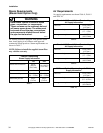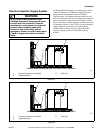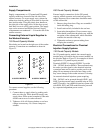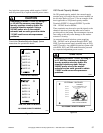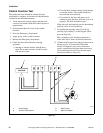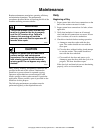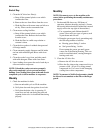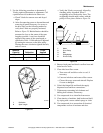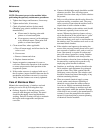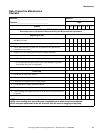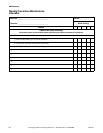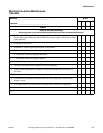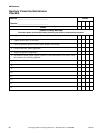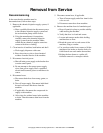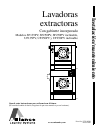
© Copyright, Alliance Laundry Systems LLC – DO NOT COPY or TRANSMIT
Maintenance
F232102
42
Quarterly
NOTE: Disconnect power to the machine before
performing the quarterly maintenance procedures.
1. Tighten door hinges and fasteners, if necessary.
2. Tighten anchor bolts, if necessary.
3. Check all painted surfaces for bare metal.
(Matching gray paint is available from the
manufacturer.)
● If bare metal is showing, paint with
primer or solvent-based paint.
● If rust appears, remove it with sandpaper
or by chemical means. Then paint with
primer or solvent-based paint.
4. Clean steam filter, where applicable.
a. Turn off steam supply and allow time for the
valve to cool.
b. Unscrew nut.
c. Remove element and clean.
d. Replace element and nut.
5. Inspect suspension components for wear or
corrosion. Observe the operation of the machine
to ensure proper tension and operation of the
suspension system.
6. If the washer-extractor is equipped with one of
the tilt options, inspect fasteners between the tilt
mechanism and washer-extractor for corrosion.
Verify that the fasteners are securely tightened.
Care of Stainless Steel
Maintain the natural beauty of stainless steel and
prolong its service life by following these tips:
● Ordinary deposits of dirt and grease can be
removed with detergent and water. The metal
should be thoroughly rinsed and dried after
washing. Periodic cleaning will help to maintain
the bright surface appearance and prevent
corrosion.
● Contact with dissimilar metals should be avoided
whenever possible. This will help prevent
galvanic corrosion when salty or acidic solutions
are present.
● Salty or acidic solutions should not be allowed to
evaporate and dry on stainless steel. They may
cause corrosion. Ensure that the stainless steel is
wiped clean of acidic solution residues.
● Deposits that adhere to the stainless steel should
be removed, especially from crevices and
corners. When using abrasive cleaners, always
rub in the direction of the polish lines or “grain”
of the stainless steel to avoid scratch marks.
Never use ordinary steel wool or steel brushes on
the stainless steel. Use stainless steel wool or soft
non-metal bristle brushes.
● If the stainless steel appears to be rusting, the
source of the rust may actually be an iron or steel
part not made of stainless steel, such as a nail or
screw. One remedy is to paint all carbon steel
parts with a heavy protective coating. Stainless
steel fasteners should be used when possible.
● Discolorations or heat tint from overheating may
be removed by scouring with a powder or by
employing special chemical solutions.
● Sanitizers or sterilizing solutions should not be
left in stainless steel equipment for prolonged
periods of time. They often contain chlorine,
which may cause corrosion. The stainless steel
should be cleaned and rinsed thoroughly of any
solution containing chlorine.
● When an external chemical supply system
is used, make certain that no siphoning of
chemicals occurs when the washer-extractor
is not in use. Highly concentrated chemicals
can cause severe damage to stainless steel and
other components within the machine. Damage
of this kind is not covered by the manufacturer’s
warranty. Locate the pump below the washer-
extractor’s injection point to prevent siphoning
of chemicals into the machine.



